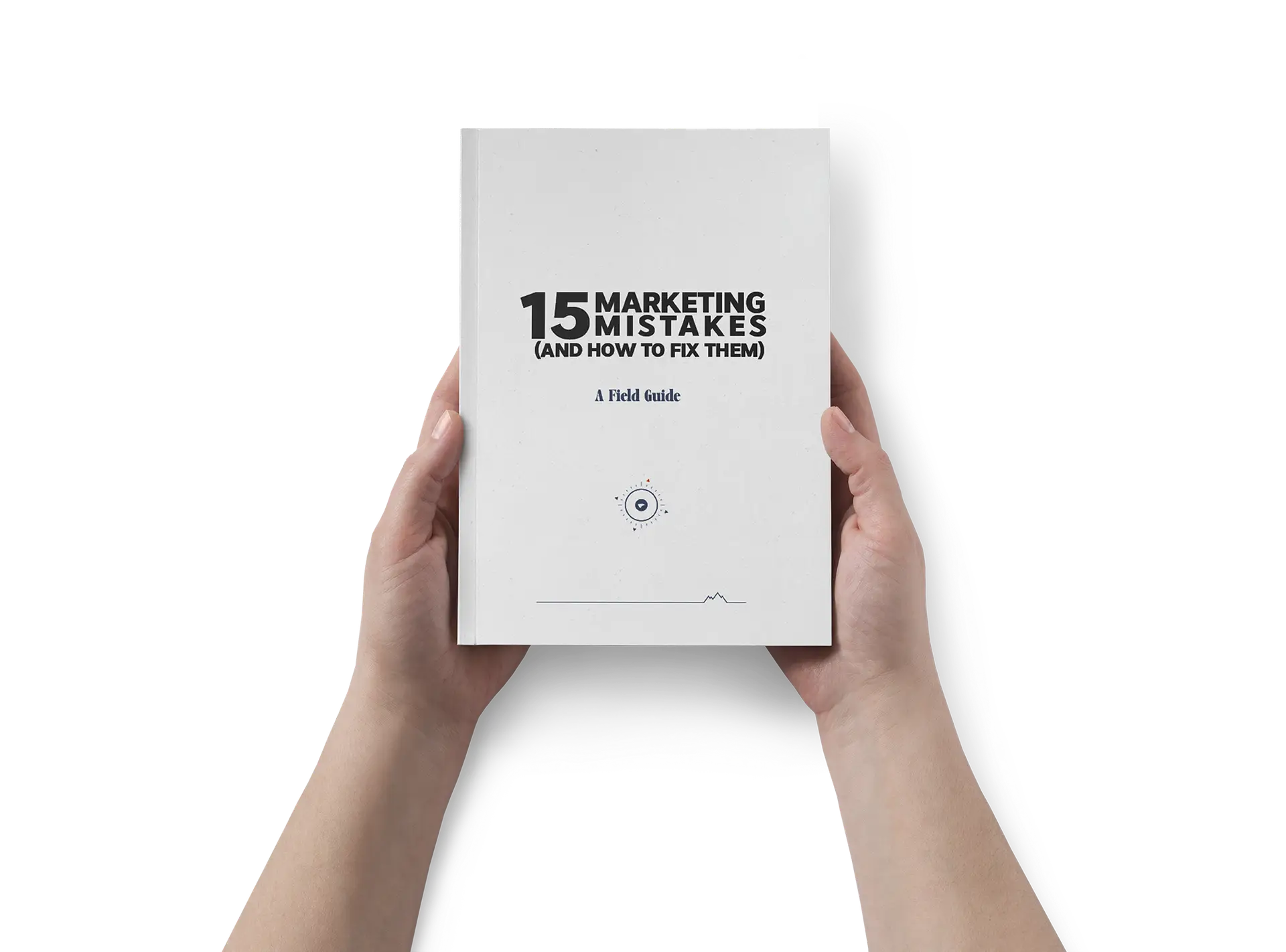TL;DR: 5 Essentials for Marketing a Construction Company in 2025
Develop a clear strategy before marketing a construction company—define goals, audience, USP, and set a realistic budget.
Build trust online with a professional website, SEO, and a complete Google Business Profile to attract local leads.
Create expert content—use blogs, videos, and case studies to showcase credibility and guide potential clients.
Blend paid and organic tactics—combine PPC ads with social media to quickly generate and nurture qualified leads.
Leverage community presence—amplify marketing a construction company with signage, events, partnerships, and strong referral systems.
Discover the complete roadmap for marketing a construction company in 2025. Here’s your complete guide. This guide includes all you need. It begins with your marketing plan’s blueprint. Then, it leads to success using both digital and traditional methods.
Construction professionals will find practical advice for building a strong brand. They’ll learn how to attract quality leads and grow their business confidently in a competitive market.
The Compass
Every building needs a blueprint, and every good marketing plan needs a strong strategy.
Marketing a construction company today can be tough. There are new things to learn, like digital ads and social media. Plus, customer expectations are always changing.
With the right plan and a desire to face challenges, you can master marketing and create a successful business. We’ll guide you through every step of making and running a marketing strategy for construction.
This guide will help you create a plan and build on it, step by step. Whether you’re a home builder, contractor, or remodeler, the principles here will help you stand out.
By the end, you’ll get a full marketing guide for your construction company. It will use plain language, include real examples, and inspire action. Let’s get started!
Why Marketing Matters for Construction Companies in 2025

These days, everyone has a camera and access to editing software. But not everyone knows how to tell a story that matters. That’s the difference.
The Importance of Digital Visibility for Construction Companies
Years ago, many construction companies relied on word-of-mouth and repeat business. While these are still important, times have changed. Now, 96% of people search online to find local services, including construction firms.
If your company lacks a website or online presence, you risk being invisible to potential clients. In fact, 62% of customers ignore businesses without a website. This makes it clear: marketing is no longer optional for construction companies; it’s essential.
Building Trust through Effective Marketing
Construction is a trust-based industry. Clients invest significant money in projects like homes and offices. They need to feel confident in your expertise and reliability. Good marketing highlights your credibility and experience, building trust before clients even contact you. It also expands the reach of your positive references.
Outperforming Competitors with Strategic Marketing
The construction sector is thriving, so competition is fierce. When someone searches for “best home builder near me,” you want your company to stand out. Smart marketing can make a local business seem larger and more established, simply by presenting a professional image and informative content.
The ROI of Marketing a Construction Company
Marketing drives growth. Companies that actively market themselves often win more projects and achieve better financial results. A recent survey showed that builders spending about 3% of their revenue on marketing had higher profit margins than those who spent less.
On the flip side, over half of builders struggling to get leads admitted they do not produce marketing content. This lack of marketing leads directly to missed opportunities.
In short, marketing your construction company in 2025 is as crucial as sturdy scaffolding on a job site. It supports everything else. It ensures your reputation, services, and brand reach those who need to hear about them. Before we explore specific strategies, let’s outline your marketing plan.
Marketing is not an expense; it’s an investment that brings in new clients and contracts.
Understanding Your Ideal Customer in the Construction Industry

Every successful marketing strategy starts with knowing exactly who you’re speaking to.
Define Your Ideal Construction Clients
In construction, this means identifying the types of clients who value your work, can afford your services, and are likely to become repeat clients or powerful referrers.
Trying to market to everyone leads to wasted effort. Instead, get crystal clear on your ideal customer—the kind of person or business that truly fuels your growth.
Start with this question: Who is your business built for?
Are you:
Building custom homes for high-end buyers?
Renovating kitchens and bathrooms for busy families?
Specializing in commercial tenant improvements for business owners?
Partnering with real estate developers or architects on new builds?
By identifying your niche and primary client types, you can focus your messaging, pricing, services, and even branding in a way that directly appeals to them.
Steps to Define Your Target Audience
Use these five steps to clearly define and document your ideal construction customer:
Segment by Project Type
Residential: First-time homebuyers, custom home clients, luxury home clients
Commercial: Retail developers, industrial facility managers, franchise owners
Renovation: Growing families, downsizing seniors, home flippers
Segment by Demographics & Psychographics
Age, income, family size, location
Values: Are they eco-conscious? Are they time-sensitive? Do they value craftsmanship or price?
Segment by Geography
Define your primary service regions—cities, neighborhoods, or development zones
Consider creating separate marketing campaigns or landing pages for each region (e.g., “Luxury Home Builder in Fort St. John” vs. “Kitchen Renovations in Dawson Creek”)
Identify Customer Pain Points
What do they worry about when hiring a builder? Budget? Timelines? Trustworthiness?
What objections do you hear most? Build messaging to proactively address these.
Define Buyer Roles in the Process
Who makes the final call? The homeowner, the project manager, the architect?
Tailor your content and pitch to the decision-makers.
Create a Customer Persona
To bring this all together, build customer personas—detailed, fictional profiles of your ideal clients. This helps keep your marketing and messaging focused and aligned. Each persona should include:
Name and job title (e.g., Sarah – Busy Professional, age 42, looking for kitchen remodels in urban neighborhoods)
Goals (e.g., increase resale value, modernize outdated kitchen, improve layout)
Pain points (e.g., limited time, not sure who to trust, overwhelmed by options)
What they care about (e.g., quality workmanship, clear communication, budget transparency)
Where they spend time (e.g., Facebook, local magazines, Google searches for “best contractors near me”)
Why It Matters
When you understand your ideal customer, everything else becomes easier:
Your website copy speaks directly to their needs.
Your social media content is tailored to what they care about.
Your ads reach the right people with messages that resonate.
Your lead quality improves—less tire-kicking, more serious buyers.
Instead of casting a wide net, you’re using a well-aimed spotlight—showing the right people exactly why your construction company is the perfect fit.
💡 Tool Recommendation: Use HubSpot’s free Make My Persona tool to build and visualize detailed customer personas you can share with your team or marketing partner.
Creating a Construction Marketing Strategy That Works
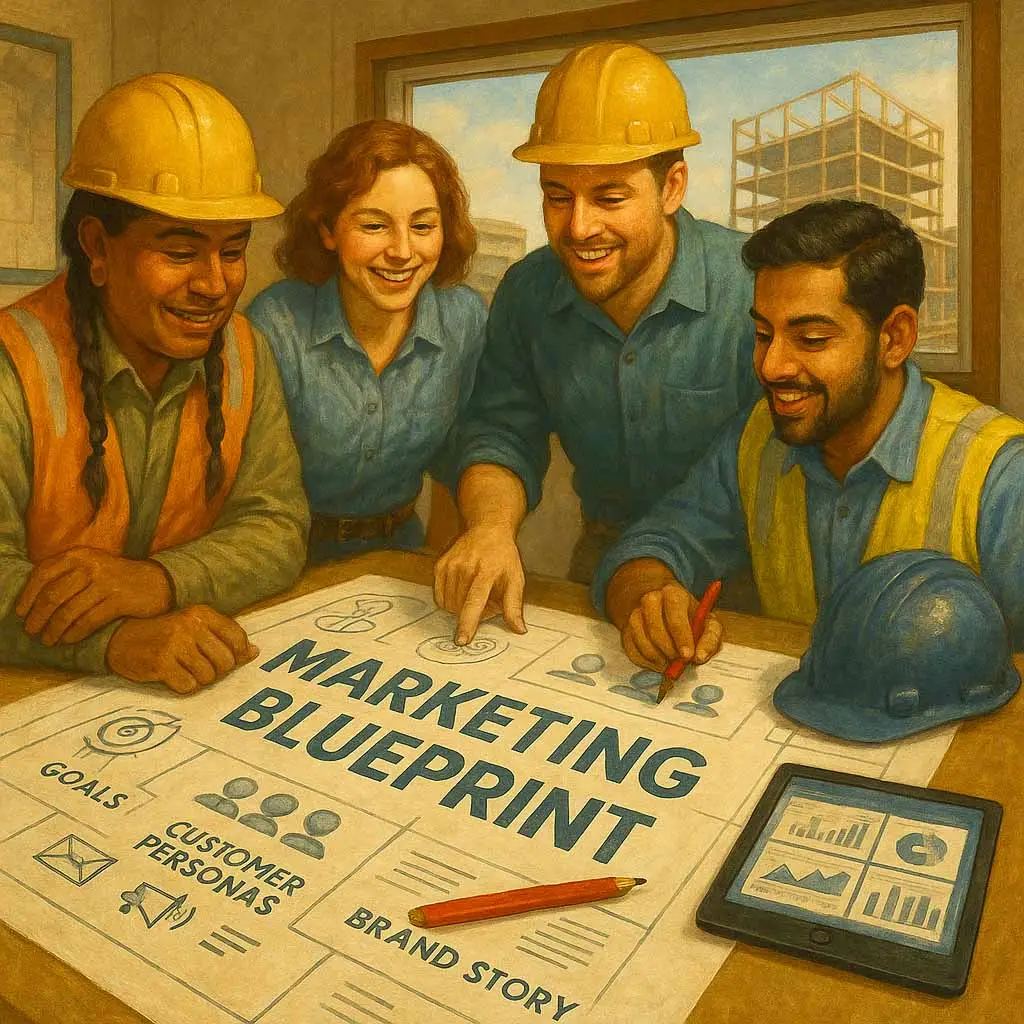
Every successful marketing strategy starts with knowing exactly who you’re speaking to.
Every successful building project starts with a solid plan, and your marketing strategy is no exception.
Jumping into advertising without a clear direction is like building on shaky ground—it’s a recipe for disaster. Take a step back and create a detailed plan for marketing your construction company.
Identify Your Construction Company’s Unique Selling Proposition (USP)
In a crowded construction market, what makes your company unique? What’s your special twist or strength?
Maybe you finish projects faster, use sustainable materials, or have a great safety record. Your unique selling proposition (USP) is the value that only you can offer.
Write down a short statement that sums up your USP—something like “We build dream homes on time and on budget” or “Leading commercial builder with a 100% safety record.” This message will be key to your marketing.
In an upcoming section, we will explore developing your Brand Script and One Liner.
Craft a Compelling Brand Story for Your Construction Business
Marketing is also about telling your story and building trust. Construction may be hands-on work, but emotions play a big role in clients’ decisions. Take a moment to outline your company’s history and values.
Why did you start the business? What drives your team? Shape a narrative that feels authentic and will resonate with clients.
And don’t forget your visual branding—make sure your logo, colors, and website design look professional and consistent.
Set Clear Marketing Goals for Growth
What do you want to achieve with your marketing efforts? Be specific: “Get 5 new client inquiries per month,” “Boost website traffic by 50% this year,” or “Grow our Instagram followers to 2,000 and generate 3 leads a month.”
Clear goals will help you choose the right tactics and measure success later. Make sure your goals are realistic but ambitious enough to motivate you and your team.
Allocate a Realistic Marketing Budget
Just as you budget for quality materials and skilled labor, you need to budget for marketing.
A good rule of thumb is to allocate 2-5% of your revenue to marketing. If you’re just starting out, you might start with a smaller budget and increase it as you see results.
The key is to commit to something – even a modest budget can go far if used wisely.
Select Effective Marketing Channels for Construction Firms
Now that you know your audience, USP, story, goals, and budget, choose the marketing channels that make sense for you. You don’t have to do everything at once. Pick a mix of strategies that fit your resources and audience.
For example, a small residential contractor might start with a great website, a Facebook page, and join a local home builders’ association. A larger B2B construction firm might focus on search engine optimization (SEO) and attending industry trade shows.
By creating this marketing blueprint, you’ve essentially drawn the plans for your outreach and growth. You know who you’re targeting, what makes you special, and how and where you’ll communicate your message.
This upfront work will make the next steps much easier and more effective. Now, with the plan in hand, let’s start building your marketing presence step by step.
Builders who allocate 3% of their revenue to marketing achieve higher net profit margins, reinforcing the ROI of marketing.
Build a Clear Marketing Plan Using the 5 Steps from Marketing Made Simple
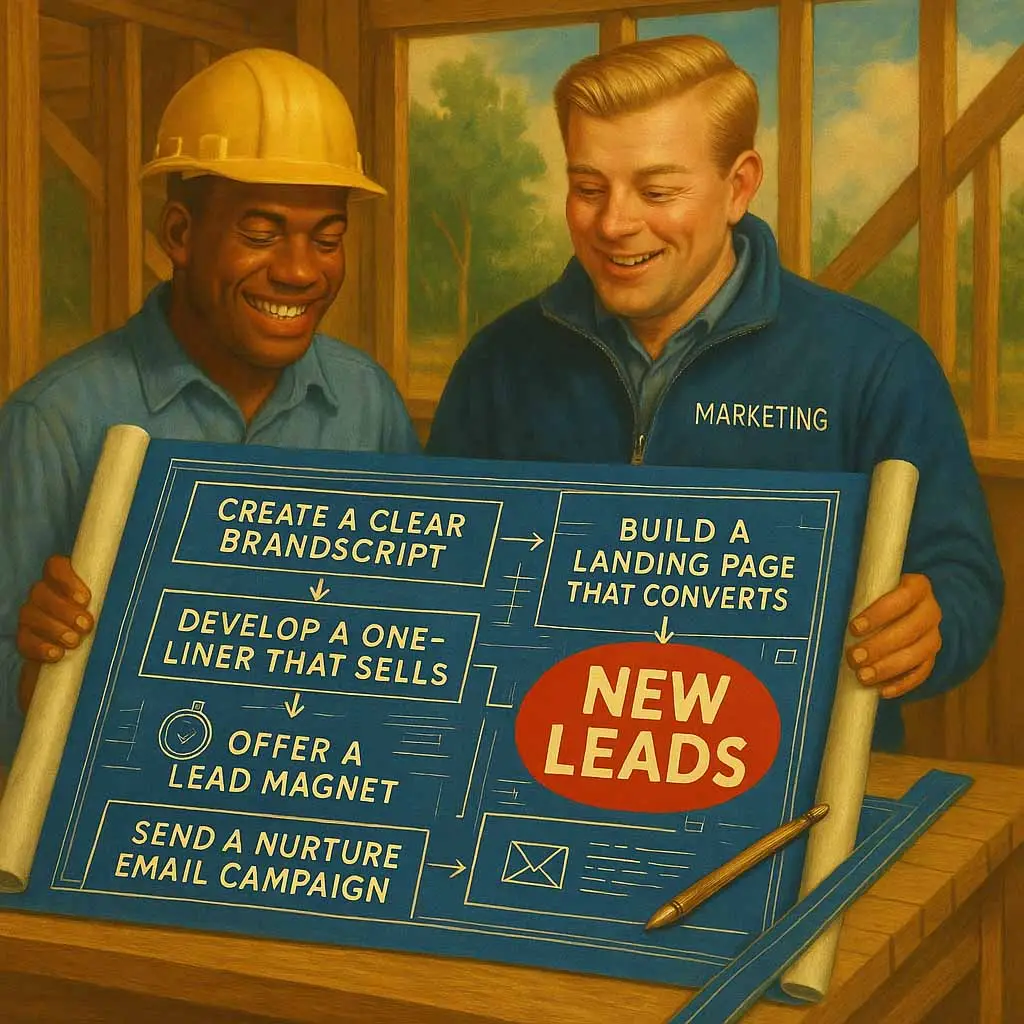
If you’re serious about marketing a construction company, you need a clear, repeatable plan that turns curious visitors into paying clients.
That’s exactly what Donald Miller outlines in his book, Marketing Made Simple. His five-step framework simplifies your messaging and connects all your marketing tools—website, lead magnets, emails—into a system that works together to grow your business.
Here’s how to apply his five-step plan to your construction company:
1. Create a Clear BrandScript
This is the foundation of your message. Instead of talking about yourself, use your BrandScript to focus on the customer’s journey. Position your ideal client as the hero, and your construction company as the trusted guide.
Your messaging should answer:
What does your customer want?
What’s getting in their way?
How can you help them succeed?
Example: “You want a home built with integrity. We help you plan and build it without the stress.”
2. Develop a One-Liner That Sells
This is your elevator pitch—simple, clear, and easy to repeat. It should highlight the problem you solve, how you solve it, and the success your client experiences.
Example: “We build beautiful, long-lasting homes—without the headaches—so families can enjoy where they live.”
Use your one-liner on your website, social media bios, truck signage, and email signature.
3. Build a Landing Page That Converts
Your website homepage (or landing page) should act like a clear, friendly guide—not a cluttered brochure.
It should include:
A clear headline and subheadline
A call to action (e.g., “Request a Free Quote”)
A list of benefits
Testimonials or project photos
A simple breakdown of your process
This structure helps visitors quickly understand how to work with you—and why they should.
4. Offer a Lead Magnet
Many people visit your site just to browse. A lead magnet (like a downloadable guide or checklist) gives them a reason to stay connected.
Ideas for builders:
“10 Questions to Ask Before Starting Your Renovation”
“Complete Home Building Budget Planner (Free PDF)”
Offering value builds trust and grows your email list—turning cold visitors into warm leads.
5. Send a Nurture Email Campaign
Once someone downloads your lead magnet, don’t just let them sit in your inbox. Create a simple automated email series that educates, builds trust, and invites them to take the next step.
A good sequence includes:
A welcome email with the download
A story or testimonial from a past client
A few helpful tips related to your services
A final call to schedule a consultation
Even if they’re not ready to build today, your emails keep your construction company top-of-mind.
Want to dig deeper into this system?
Pick up a copy of Marketing Made Simple by Donald Miller.
It’s a straightforward, practical read—especially if you’re running your own business or trying to streamline your marketing without the fluff.
Many of the branding and marketing strategies we offer at EV Agency are built on this proven framework.
Builders who allocate 3% of their revenue to marketing achieve higher net profit margins, reinforcing the ROI of marketing.
Branding Your Construction Company for Long-Term Success

Every successful marketing strategy starts with knowing exactly who you’re speaking to.
Branding goes far beyond your logo or business name—it’s how your construction company is remembered, trusted, and chosen.
In a competitive industry where reputation is everything, strong branding gives your company a clear identity that sets you apart from the rest.
It’s not just about looking professional—it’s about being recognized as the reliable, skilled, and values-driven builder clients want to work with.
Why Branding Matters in Construction
Construction is a high-stakes, trust-based industry. Clients aren’t just hiring you to pour concrete—they’re trusting you with their homes, businesses, and dreams. A clear, consistent brand builds that trust before a single meeting. It tells people what you stand for, what you promise, and what kind of experience they can expect.
Think of your brand as the foundation of your entire marketing strategy. It supports every message, photo, video, and handshake. When done right, branding makes every marketing effort more powerful—because your message is anchored in clarity and purpose.
Elements of a Strong Construction Brand
To build a brand that lasts, start with the core pillars:
Brand Messaging: Define what your company believes in and how you solve problems. Are you the go-to contractor for energy-efficient homes? Do you specialize in heritage restorations with a modern twist? Clear messaging helps you attract the right clients and win better projects.
Visual Identity: From your logo and colors to truck signage and job site banners, visual consistency builds recognition. A rugged, polished identity shows you take pride in every detail—on-site and online.
Brand Voice: Whether on your website, emails, or social media captions, how you speak matters. Your voice should reflect your values—confident, honest, down-to-earth—and speak directly to your ideal clients.
Consistency Across Touchpoints: Your brand should feel the same across your website, quotes, brochures, and customer interactions. That alignment builds familiarity and makes you easy to remember and refer.
Branding Builds Long-Term Value
Companies with strong brands don’t just get more leads—they get better ones. People pay more for a builder they trust.
A clear brand positions you as the expert, speeds up trust, and makes price less of a sticking point.
It also makes hiring easier, attracts quality subcontractors, and even improves internal culture by rallying your team around shared values.
Need Help Defining or Refreshing Your Brand?
At EV Agency, we specialize in helping construction companies create rugged, trustworthy brands that clients remember—and recommend.
From clarifying your message to designing your logo and visual identity, we build brands that support your long-term growth.
Want to see how branding can elevate your construction business?
Explore our Branding 101 Field Guide or get in touch to start building a brand that works as hard as you do.
Get our Free Guide – 15 Marketing Mistakes & How to fix them.
Download our free eBook that uncovers 15 common marketing mistakes and how to avoid them.
Building a High-Performing Website for Your Construction Company

In the digital landscape, a professional website stands as your company’s cornerstone.
Imagine it as the solid concrete foundation of a sturdy home—it holds everything together.
Without it, your marketing efforts may crumble under pressure. It’s the essential tool that elevates your construction company above the competition. Build your online presence wisely, and watch your brand flourish.
When someone hears about your business, their next step is usually to look you up online. What they find will either build trust—or raise doubts. A high-performing website not only makes a strong first impression, it works day and night to turn casual visitors into serious leads.
Follow a Proven Structure for Better Results
To make your website truly work for you, structure it like a well-planned project. Donald Miller’s Marketing Made Simple framework offers a landing page wireframe that construction companies can follow to guide visitors through the decision-making journey.
Here’s how to structure your website using his five-part approach:
1. Clear Header: Speak to What Your Clients Want
Start with a bold headline that promises a result they care about.
Headline example: “Custom Homes Built Without the Stress.” Subheadline: “From permits to the final walkthrough, we manage every step so you don’t have to.”
Include a Call to Action right away—like “Request a Free Quote” or “Schedule a Consultation.” This should appear at the top and throughout the site.
2. Show the Stakes: What Happens if They Don’t Choose Wisely
Help visitors feel the urgency. Explain what’s at risk if they go with the wrong contractor—delays, budget overruns, poor workmanship.
Example: “Don’t risk hiring a builder who leaves you over budget and behind schedule. We help you avoid costly mistakes.”
3. Communicate Value: What They’ll Gain
Use bullet points, icons, or visuals to highlight the clear benefits of working with you.
Licensed and insured team
Transparent quotes and timelines
Award-winning customer satisfaction
Local experience and trust
Support this section with visuals, project photos, or testimonials to build confidence.
4. Establish Trust: Be the Guide
Use your “About” section to show you’re experienced, relatable, and professional. Introduce your team, your values, and your track record.
Example: “We’ve completed over 150 builds and renovations across BC—each one with craftsmanship and care.”
This is where you can also link to client reviews or professional credentials (like certifications or memberships).
5. Outline a Simple Plan
Most construction clients don’t want complexity—they want clarity. Show them how easy it is to work with you in three steps:
1. Schedule a call 2. Approve your custom plan 3. Watch your vision come to life
Make this plan visual and repeat it with your call to action: “Let’s build something great—start your project today.”
Add a Lead Magnet to Capture Emails
Some visitors aren’t ready to book yet. Offer them something valuable in exchange for their email address.
“Download our Home Renovation Planning Checklist”
“Free PDF: How to Budget for a Custom Build”
Place this opt-in form below your main content or as a popup. Once they subscribe, follow up with a short email series to build the relationship.
Showcase Social Proof: Real Stories from Happy Clients
Use testimonials, before-and-after galleries, or case studies to build credibility. This reinforces the promises you made above.
Keep It Clean, Fast, and Mobile-Ready
Even the best content won’t work if your website is clunky or outdated. To make your website high-performing:
Use large, crisp photos of your work
Optimize for mobile and fast load speed
Keep navigation intuitive—think of it like a tidy job site
Use consistent branding, fonts, and colors across all pages
Your website should feel like walking through a well-organized home build—everything in the right place, easy to navigate, and built to impress.
If you’re ready to turn your website into your strongest sales tool, EV Agency can help. We design high-converting websites for construction companies using this proven wireframe—customized to fit your brand, message, and market.
Construction SEO: How to Rank in Local Search Results
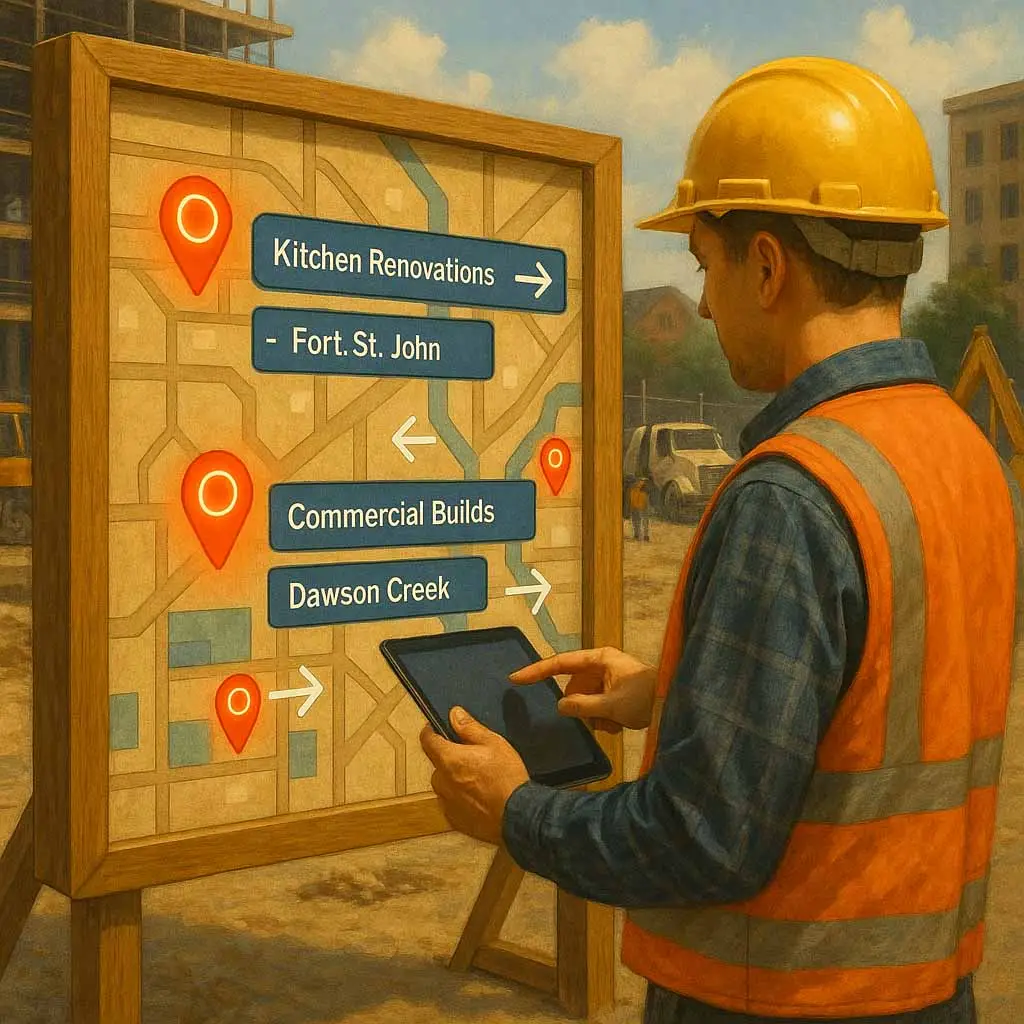
Having a great website is just the first step – the next step is making sure people actually find it. This is where Search Engine Optimization (SEO) comes in.
SEO helps your site rank higher on search engines like Google. This is for keywords such as “home builder in Calgary” or “commercial contractor near me.”
For construction companies, local SEO is super important – you want to show up in searches in your service area.
Here are some SEO strategies to boost your visibility:
Optimize Your Google Business Profile:
One of the quickest ways to improve your local search presence is to claim and optimize your Google Business Profile. It’s free, and it lets your company show up on Google Maps and the local 3-pack results.
Complete your profile.
Address
Service areas
Hours
Phone number
Website
Business description
Add some high-quality photos of your projects, logo, and team. Ask happy clients to leave Google reviews.
High star ratings and positive reviews boost your ranking and build trust. This profile is essential for local SEO, so don’t skip it.
Use Relevant Keywords on Your Site:
Think about what your ideal clients might type into Google. It could be broad terms like “custom home builder in Calgary” or very specific queries like “kitchen remodeling contractor affordable”.
Make sure your website’s text naturally includes the key services and locations you target.
For example, on your homepage and services pages, use phrases like “residential construction in Calgary” or “licensed commercial contractor with 20 years experience”.
Don’t overdo it with keywords – write for humans first, but make sure the basics are there. Each page should have a clear topic and relevant terms in the title and headings.
Create Location-Specific Pages or Content:
If you serve various towns or neighborhoods, you might want to create separate pages or sections for each. Highlight local projects or testimonials – for instance, a page for “Home Construction in Edmonton” and another for “Commercial Renovation in Calgary” if those are big markets for you.
This can help you rank when people search specifically with those place names. Even a blog post spotlighting a project in a particular community can appear in searches.
Backlinks and Citations:
A “backlink” is when another website links to yours – it’s like a vote of confidence that can improve your rankings. You can earn backlinks by getting listed in online directories.
Look at construction or trade directories, local chambers of commerce, and builder associations. Also, create great content that others will want to reference.
Citations are when other sites mention your business name and info. Keeping your details consistent on platforms like Yelp, Houzz, HomeAdvisor, and Angie’s List can boost your local presence. Spend some time getting listed on these sites – many have free listing options.
Technical SEO Basics:
Ensure your site’s tech is strong. Each page should have a clear title tag, like “ABC Construction – Custom Home Builders in Alberta.”
Also, include a meta description that encourages clicks. Use headings logically in your page content.
If you can, install Google Analytics or another tracking tool. It’s not just for SEO; it helps you see how much traffic you get and where it comes from.
SEO may sound technical, but it’s simple. Focus on making your site helpful and relevant to what people search for. Also, ensure Google knows your business details. The payoff is big.
If your site ranks on the first page for “best construction company in your area,” you’ll get a steady flow of organic leads. Plus, you won’t have to pay for each click.
Here’s another local tip: 96% of people search online for local businesses.
Strong SEO acts like a sign on the busiest road in town. It brings traffic straight to you.
Use Content Marketing to Power Your Lead Generation Plan

Content marketing isn’t just about blogs and videos—it’s a key part of a proven system for marketing a construction company.
By creating helpful content, you position your company as an expert and the go-to resource in your field.
When done right, it supports every stage of Donald Miller’s five-step plan: from attracting attention to nurturing leads into real jobs.
By consistently sharing helpful, relevant content, you show potential clients that you’re the expert they can trust—and that confidence is what gets the phone ringing.
How Content Marketing Fits Into the Five-Step Plan
Let’s connect the dots:
Step 1: Clarify Your Message
Content makes your BrandScript real. Every blog post, video, or checklist should reinforce your clear message: who you help, how you help, and what success looks like.Step 2: Use a One-Liner
Lead each blog post or video with a version of your one-liner. This consistent statement strengthens your brand and keeps your offer top-of-mind.Step 3: Drive Traffic to Your Website or Landing Page
Your content—especially blog posts, social videos, and infographics—brings people to your site. There, a well-built landing page guides them toward your next step (like requesting a quote).Step 4: Offer a Lead Magnet
Guides, checklists, and downloadable resources are perfect lead magnets. Include them within or at the end of your content to collect email addresses.Step 5: Nurture Leads with Email Campaigns
Once someone downloads your guide, continue the conversation. Follow up with more content—videos, project spotlights, or FAQs—to keep them engaged and ready to book.
What Content Works Best for Construction Companies?
Start with content that answers real client questions or showcases your work. Here are the most effective formats:
Blog Posts and Articles
Educate your audience and build trust with informative articles like:
“5 Mistakes to Avoid When Hiring a Contractor”
“What to Expect During a Full-Home Renovation”
“Top Questions to Ask Before You Build”
Write in plain language, answer common concerns, and link back to your services.
Project Case Studies
Share before-and-after stories that highlight your process and outcomes:
“Case Study: How We Transformed a 1970s Bungalow into a Modern Family Home”
Include challenges, solutions, and photos.
These act as detailed testimonials—great for SEO and sales.
Short Videos and Timelapse Footage
A 30-second timelapse of a framing day. A drone flyover of a finished home. A walk-and-talk explaining insulation choices. These videos bring your projects to life—and work beautifully on social media.
Post them to Instagram, Facebook, TikTok, and your website.
Free Guides and Checklists (Lead Magnets)
Perfect for Step 4 in the plan. Offer value in exchange for an email:
“Ultimate Guide to Planning a Home Addition”
“Budget Checklist for First-Time Homebuilders”
Place a strong call to action on your blog or homepage: “Download Now to Start Planning Smarter.”
Visual Content: Photos & Infographics
Showcase your craftsmanship. Create graphics that explain the stages of a renovation, green building options, or the benefits of energy-efficient materials. These are easy to share and boost brand recognition.
Start Small, Stay Consistent
Content marketing is a long game. You might not get leads overnight, but every article or video you publish builds trust and visibility. Over time, your content becomes a digital footprint that guides new leads straight to your door.
If writing or filming isn’t your thing, no problem—focus on providing the insights and hire help for the rest. The key is to start, stay consistent, and use each piece to support your five-step lead generation plan.
market your construction company with EV Agency Photography





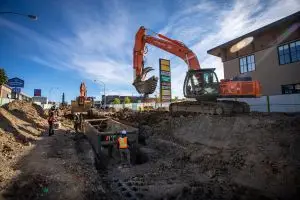
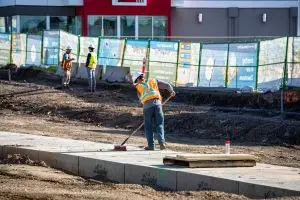
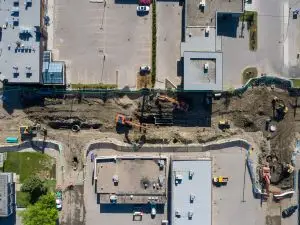







Using Social Media to Attract New Construction Clients
Social media isn’t just for trendy consumer brands – it’s a powerful (and often free) marketing tool for construction companies too. In construction, visuals speak louder than words, and social platforms are essentially visual storytelling channels.
By sharing updates and interacting online, you keep your company top-of-mind for followers who could turn into clients or refer you to others. It’s also a great way to show the human side of your business and build a community around your brand.
Consider these social media strategies for a construction business:
Choosing the Right Social Platforms for Your Construction Business:
You don’t have to be everywhere – pick platforms that your target customers likely use.
For residential construction or remodeling, Facebook and Instagram are excellent for showing photos and videos of projects, and local community engagement. Instagram, especially, lets you share high-quality images of finished work or short reels of work in progress.
For commercial construction or B2B-focused companies, LinkedIn can be useful to network with developers, architects, and business owners by sharing company news or thought leadership posts about industry trends.
YouTube is great for longer videos (like project walkthroughs or client testimonial videos). And emerging platforms like TikTok have a surprising number of home improvement and DIY fans – a clever before-and-after or a “day in the life of a contractor” clip can get traction there.
Choose 2-3 platforms to focus on, based on where your audience hangs out.
Show Your Projects and Process:
Social media is perfect for showcasing visuals. Post photos of your ongoing projects (with the owner’s permission, of course).
People love to see transformations – so share that bathroom remodel progression or the freshly poured foundation of a new house with a caption about the milestone. Before-and-after photos are especially popular and share-worthy.
Also consider posting short clips: a timelapse of a day’s work on site, a quick video of your team celebrating a project completion, or a 360° video tour of a finished build. These give followers a sense of being part of the action.
Share Tips and Knowledge:
Just like with blog content, you can micro-blog on social media. For instance, post a tip of the week: “Tip Tuesday: Did you know installing XYZ insulation can cut energy costs by 20%?
Little upgrades like this make a big difference in new home builds.” Such posts position you as an expert and are likely to be saved or shared by homeowners considering projects.
You could also do a short Q&A in a live video or an Instagram story – answer common questions like “How long does a kitchen reno typically take?” or “What permits do you need for a home addition?”.
This kind of informative content builds trust and keeps people engaged.
Engage and Be Responsive:
Social media is a two-way street. Don’t just post and ghost. Respond to comments and messages promptly. If someone asks, “What flooring is that in the picture?” reply with an answer.
Thank people for compliments. Handle any negative comments with professionalism and a helpful attitude (this shows your potential customers how you deal with issues).
Also engage with other local businesses or partners – comment on the posts of an architect you work with, or share a post from a local hardware store you like.
Being active and friendly on social media expands your reach and forms positive associations.
Use Local Hashtags and Geotags:
On platforms like Instagram and Twitter, using hashtags can help new people find your content. Tag posts with things like #Construction, #HomeBuilding, but also local tags like #[YourCity]Builder or #[Region]Construction.
On Instagram, geotag your photos with the location of the project or your business. Local folks often browse posts from their area and might stumble on your beautifully built home photo, leading them to your profile.
Highlight Your Team and Company Culture:
Some of the most engaging posts can be about your team or company culture. Post a photo of your crew at work (with their smiles or focus showing), or doing a fun activity like a team BBQ.
Highlight an employee of the month with a mini-bio (“Meet John, our master carpenter who’s been building for 15 years…”). If your company participates in charity builds or community events, definitely showcase that.
These posts make your company relatable and likable – people prefer to hire folks they feel they know and trust.
Consistency is key on social media. Aim to post regularly (say a few times a week) so that you stay visible to your followers.
You can use scheduling tools or assign someone on your team to handle social updates if it gets too time-consuming.
Over time, as you grow your follower base, you’ve essentially built a free marketing channel: whenever you have a new offer or want to announce a service, you have an audience ready to hear it.
Social media also indirectly helps your other marketing efforts. For example, if someone googles your construction company name, your Facebook or Instagram might show up, giving them additional proof of your activity and happy clients. It all works together to bolster your credibility.
Advertising Online and Offline: What Works Best in 2025?
While SEO, content, and social media are crucial, they can take time to gain traction. If you’re looking to generate leads quickly or boost visibility for specific services, online advertising is the way to go.
The most common type of online ad is PPC, where you pay to show your ad in search results or social feeds and get charged when someone clicks it.
The good news is that in construction, digital ad costs are pretty reasonable – the average search ad click cost is about $2.50, and those clicks can lead directly to high-value projects.
Here are some online advertising options to consider:
Effective Google Ads Strategies for Construction Companies
These text ads show up at the top of Google search results. You can bid on keywords like “bathroom remodeler [City]” or “commercial contractor”.
When people search those terms, your ad can appear above the organic results, and you only pay if they click through to your site. The best part is that you can start showing up on page one of Google by tomorrow if you set up a campaign today.
For best results, target specific keywords that indicate a ready buyer, like “get deck built [City]”. You can also target people within your service area so your ads only show to them.
Google Local Services Ads (LSAs)
LSAs are a great option for local service providers like contractors. These ads show up at the very top with a “Google Guaranteed” badge, and you pay per lead rather than per click.
To use them, you’ll need to go through a quick verification process. LSAs are perfect for general contractor searches, as they display your business with reviews and contact info front and center.
Facebook and Instagram Ads
Social media ads let you target people by demographics, interests, or location.
For example, you could run a Facebook ad showcasing a beautiful kitchen remodel photo with the caption “Dreaming of a New Kitchen? We can build it. Get a free consultation!” and target it to homeowners in your area who have “Home Improvement” or “Interior Design” interests.
Facebook/Instagram ads are usually visual and can generate awareness and leads. They’re relatively affordable and great for building your local brand.
Retargeting Ads
You know how sometimes you visit a website, and then you start seeing that company’s ads everywhere? That’s retargeting.
You can set up retargeting ads via Google or Facebook to show ads to people who visited your site but didn’t contact you. This way, you can gently nudge them to come back and check you out.
Promote Your Construction Business with Video Ads
If you have a great promo video, you can run it as an ad on YouTube or Facebook. Video ads can be really impactful, but they do require good visuals.
For instance, a 15-second YouTube ad might show a quick montage of your projects with text like “Building [City]’s future, one home at a time – Contact [Your Company]”.
YouTube allows targeting by location and interests, so you can aim at viewers watching home improvement videos.
When running paid ads, always have a clear goal and a way to measure results. Link the ads to a specific landing page on your site that matches the message.
Use call tracking or unique contact forms to see how many leads come from ads, and track your ROI.
For example, if you spend $200 on ads and get one deck project worth $20,000, that’s a great return! Over time, you can adjust your ad spend to focus on what works best.
Here’s an encouraging stat: Businesses can earn an average of $2 for every $1 spent on pay-per-click ads, essentially doubling their investment. Paid advertising can be a game-changer when done right. It’s like adding a motor to your marketing efforts – it gives you an extra boost to reach prospects faster.
Now that we’ve covered online advertising, let’s not forget that marketing isn’t just online. Offline and in-person marketing still hold huge value, especially in construction.
In the next section, we’ll explore how to combine digital strategies with traditional methods to cover all bases.
Traditional Marketing Tactics Still Relevant for Construction Companies
Marketing a construction company is all about building a bridge between old-school methods and new ones. We’ve covered digital marketing, so now let’s talk about tried-and-true methods that have worked for decades.
Traditional marketing and community engagement can do a lot to help your brand and reach local customers who might not find you online. The best approach in 2025 is a hybrid one: blend your digital efforts with boots-on-the-ground tactics.
Here are the key traditional strategies to incorporate:
Encourage Referrals and Word-of-Mouth
In construction, word-of-mouth is incredibly valuable. A recommendation from a friend, neighbor, or colleague instantly establishes trust. Even with all the digital options today, a large portion of construction business still comes from referrals. In fact, one study found that about 54.8% of builders said referrals accounted for over half of their sales.
That’s why you shouldn’t just rely on referrals – it’s not something you can directly control or scale easily. So, be proactive and encourage word-of-mouth:
Ask for Testimonials and Reviews:
Every time you finish a project, ask your satisfied clients for a short testimonial. This could be a written quote on your website or a quick review on Google, Houzz, or Facebook. People like to support good businesses, but they often need a little nudge.
For example, send a friendly email after the project’s done: “We loved building your new deck! If you’re happy with it, could you leave us a quick review? It really helps.” Make it easy for them by providing a direct link to your Google review page.
Offer Referral Incentives:
Consider starting a referral program, especially if you’re in a segment where referrals could be consistently encouraged (like home renovations).
For instance, you could offer past clients a $100 gift card or a discount on future services if they refer someone who ends up hiring you. A simple thank-you gift or a handwritten note for referrals go a long way too.
Let people know you appreciate referrals on social media or in your newsletter: “Did you love our work? Tell a friend! We’ll send you a thank-you reward for any new project we get through you.”
Maintain Relationships:
Stay in touch with past clients every now and then, so they remember you. This could be through an email newsletter every quarter (sharing company updates or home maintenance tips) or even holiday cards.
When you keep relationships warm, those clients are more likely to mention you to others or call you for their next project. It’s much easier to generate repeat and referral business from someone who already trusts you.
Leverage Networking (In-person):
Word-of-mouth isn’t just from clients; it can come from anyone who knows and respects your work. This includes architects, real estate agents, property managers, or other contractors in complementary trades. Building a network of industry contacts expands the circle of people who might refer you.
The bottom line is that every completed project is a marketing opportunity. By delivering quality work and a great customer experience, you create ambassadors for your business.
Each happy customer might tell 2-3 others, and those personal recommendations often turn into your easiest sales. So uphold high standards in your work and don’t be shy to ask your cheerleaders to spread the word.
Network and Partner in The Community
Being a part of the local community is a big deal for construction businesses. It can lead to some amazing connections and opportunities. Think of it like building genuine relationships that eventually turn into business. Here are some ways to network and partner effectively:
Get Involved in Local Groups:
Join local groups like the Home Builders Association or Chamber of Commerce. Attend their events to meet professionals. You might find developers seeking subcontractors or suppliers who can refer clients. Membership also boosts your credibility.
Attend Local Events and Trade Shows:
Attend local home and garden shows, real estate investor meetups, and construction trade expos to meet potential clients and partners. Bring marketing materials and be prepared to talk about your specialty.
Partner with Businesses that Complement Yours:
Partner with businesses that serve your target audience, but aren’t competitors. For instance, home builders can connect with local real estate agents, who know when clients need a builder. This can lead to a win-win referral arrangement.
Get Involved in the Community:
Get involved in your community. Sponsor a local team or volunteer for a good cause. This gets your name out there and shows you care about the community.
Network Online:
In-person networking is great, but don’t forget about online networking. Platforms like LinkedIn can be used to connect with commercial clients or other contractors.
Facebook groups or forums about local home improvement can also be places to chime in with advice. For example, if someone asks for advice on a Facebook group, you can comment with some general tips and say you’ve done similar projects.
The key to networking is being genuine and engaging. Be friendly, be helpful, and show interest in others’ work. It’s not about handing out business cards to everyone you see; it’s about building relationships that will pay off in the long run.
Get Noticed with Print Marketing and Signage
Even in 2025, old-school print marketing still works, especially in industries like construction where people are physical and on-the-ground.
Think about it: if someone drives by a house being built or renovated, they might wonder who is behind the project – a sign with your company name and contact info provides a quick answer. Here are some classic print and physical marketing tactics that get the job done:
Job Site Signs:
Put a sign on the yard or site fence with “Quality work by [Your Company Name]” and your phone number and website. It grabs attention from neighbors and passersby, and can attract potential clients in the area.
Brand Your Work Vehicles:
Turn your work trucks into moving ads. Put your company name, logo, and contact info on your vehicles. It’s a small cost that pays off big. Everywhere your team drives, people will see your brand. Make sure the design is clear and easy to read.
Business Cards and Brochures:
Carry business cards with you, featuring your logo, name, title, and contact details. Also, consider a simple brochure showcasing your services and work.
Targeted Direct Mail:
Target neighborhoods you know or areas with old homes needing renovation. Send a postcard with project photos and a special offer. Use services that target specific postal routes or income levels. One successful mailing can pay for itself. Highlight your unique selling points and include a clear call to action.
Print Ads in Local Media:
Advertise in local papers, real estate mags, and church bulletins. Target new homeowners in real estate publications. Keep ads simple and consistent in publications your audience reads. Include your logo, tagline or services, and contact info. Ask callers how they found you to track leads.
Door Hangers or Flyers:
Leave flyers or door hangers in nearby homes after a job, saying “We just finished a project next door! Need improvements? Call us.” Be respectful, not intrusive.
Alternatively, leave extra business cards with your client.
Physical marketing methods like these still have a lot of power. They’re personal, tangible, and can significantly influence local customers.
People have a reminder of your company – a card in their wallet, a sign on their street, a flyer on their counter – which keeps you in mind.
Plus, not everyone is searching online; some respond better to a friendly brochure or seeing your work in person. By combining print with digital, you cover all bases.
Get Involved in Trade Shows and Community Events
We’ve talked about networking at industry events, but let’s take it up a notch: actively participating in trade shows or hosting events can really boost your reputation and lead pipeline.
It shows you’re not just a contractor, but a leader in your field and a part of the community. Here’s how to make the most of events:
Exhibit at Home Shows or Trade Fairs
Annual home shows and expos attract homeowners and businesses looking for contractors.
Invest in a booth to showcase projects with photos, videos, and interactive elements. Have friendly staff greet attendees and collect contact info with a sign-up sheet or giveaway.
Host Seminars or Workshops
Host a free workshop at a local library or community center to share your expertise. Choose a topic like “Planning Your Home Renovation Budget” and consider partnering with a hardware store.
By teaching, you’re marketing yourself without being pushy. Make sure your branding is visible and offer a take-home resource like a handout or business card.
Community Events & Sponsorship (Revisited)
Get involved in local events to raise brand awareness. Look for parades, festivals, or demos where you can participate. This shows the community you’re invested in them, making them more likely to hire you.
Open Houses or Showroom Events
Host an open house event at your physical office or showroom. Showcase a finished project or offer a tour of a newly renovated home, and make it social with local advertising and refreshments.
Industry Conferences (for B2B)
Attend industry conferences to attract big clients. Speak on construction topics to get noticed by companies that need reliable partners.
The key takeaway from all these traditional strategies is being present in your local community. By being visible and involved, you’re making it easier for people to think of you when they need a contractor.
Digital marketing can plant the seed, but real-world marketing helps cement your reputation and build trust with potential clients. By combining both, you’re creating multiple pathways for clients to find and trust you.
Stay Ahead by Embracing Emerging Construction Marketing Trends (2025)
The marketing landscape is always changing. New tools, technologies, and consumer behaviors can quickly shift what works and what doesn’t. To stay ahead of the game, it’s a good idea to keep an eye on emerging marketing trends, especially those that resonate with the construction industry. Here are some key trends for 2025 and how you can use them to your advantage:
Leverage Video and Virtual Experiences
By 2025, video is no longer just nice to have – it’s often the way people prefer to consume content. We’ve talked about including video in your content strategy, but consider pushing the boundaries further:
Live Video and Webinars
Use Facebook, Instagram, or YouTube to broadcast live. Host a site tour or Q&A session. For example, “Join us live at 12 PM to ask about our new project!” This engages your audience in real-time and shows transparency. You can also host a live webinar on a topic like “Choosing a Contractor” to attract potential clients. Promote it ahead of time and take live questions.
Virtual Reality (VR) Tours
Tech is getting more accessible. Create 360-degree virtual tours of model homes or past projects for your website or VR goggles, giving clients an immersive experience.
Drone Footage
Use drones for site monitoring and marketing. Aerial views showcase scale and impress. Post drone videos online to stand out, but follow local regulations.
Short-Form Video Trends
Watch TikTok and Instagram Reels for trending topics. Construction content is popular, with millions of views on videos like bricklaying and transformations. Align your content with these trends to reach more people. Create a 15-second video of a cool tool or a “day in the life” montage, using hashtags like #construction and #builder.
Marketing a Constuction Company with EV Agency
How AI and Automation Can Help
Artificial Intelligence is changing the game for businesses, including marketing. Don’t need to be a tech expert to make the most of AI tools:
Chatbots for Your Website
Ever seen a chat box pop up asking if you need help? That’s probably an AI chatbot. On a construction site, it could greet visitors and ask, “What kind of project do you want to do?” then guide them to the right info or ask for their contact details.
This can capture leads all day, all night – even when you’re busy. You can program a bot with common questions and answers (like “Yes, we offer free estimates” or “We serve X, Y, Z areas”). It’s like having an assistant who never takes a break.
AI for Content and Analysis
Tools like ChatGPT can help you come up with marketing ideas, social media posts, or blog outlines. Add your personal touch, and AI can speed up the writing process or get you out of a writer’s block.
There are also AI analytics tools that can predict what type of content will work best or when to post on social media for maximum engagement. These insights can help refine your strategy.
Marketing Automation
Consider using an email marketing system (like Mailchimp or HubSpot) to automate follow-ups. For example, when someone fills out a form on your site, an automated email sequence kicks in: a thank you note right away, maybe a helpful article link, then a follow-up a week later “Checking in on your project planning,” etc.
This kind of nurturing can be set up once and then runs on its own, making sure no leads fall through the cracks. It keeps guiding them back to you gently over time.
CRM Systems
A Customer Relationship Management (CRM) tool helps you track leads and past client interactions. Modern CRMs have automation too – reminding you to follow up if a proposal hasn’t been answered, or sending clients a happy birthday note.
These personal touches, aided by tech, ensure you maintain relationships (and fuel referrals) and respond promptly to new inquiries.
AI and automation might sound impersonal, but when used wisely, they actually help you provide more personalized attention by handling routine tasks behind the scenes.
They free up your time so you can focus on the human side of marketing and your actual construction projects.
Sustainability and Social Responsibility Matter
In 2025, clients are looking for companies that care about the environment and social issues. The construction industry is under a lot of pressure to be green and socially conscious. By highlighting these aspects, you can stand out from the competition.
Eco-Friendly Building Practices
Highlight eco-friendly materials, energy-efficient designs, and green building standards like LEED certification. Many customers seek sustainable construction options. Mention simple practices like recycling waste or using solar panels in marketing. Show your environmental commitment on social media or Earth Day. This positions you as a forward-thinking builder who cares about the planet.
Safety and Ethics
Clients want companies that treat workers well and prioritize safety. Highlight your safety record and community involvement to attract clients who share your values.
Hyper-Local Targeting and Voice Search
As tech gets better, targeting gets more precise.
Hyper-Local Marketing:
We’ve talked about local SEO, but hyper-local takes it up a notch. It’s all about being super specific. You could use geofencing in ads, where you show stuff to people who enter a certain neighborhood or attend a certain event.
Or create content that’s really tailored to a community, like a guide to renovating homes in a specific historic district. When people see something that really speaks to them, it makes a big impact.
Make sure your website mentions the specific areas you serve – don’t just stick to broad terms, get down to neighborhoods or suburbs if you can.
Voice Search Optimization:
More and more people are using voice search thanks to Siri, Alexa, and Google Assistant. They might ask, “Hey Google, find a custom home builder near me who does modern farmhouses.” Voice searches are usually in the form of questions or sentences.
To catch these, include natural language phrases on your site that sound like how people talk. An FAQ section is great for this – questions like “How do I choose a good construction company?” could be on your site and match a voice search.
Also, don’t forget to update your Google Business Profile, since a lot of voice searches pull answers from there. Think about what questions clients might ask and make sure the answers are easy to find in your content, written in a way that feels conversational.
Final Word on Embracing Trends
To keep your marketing fresh, stay on top of trends like video, AI, sustainability, and voice search. Not every trend will be a good fit for every business, but being adaptable is key to success. Pioneers who try new approaches can often outrun bigger companies that are slower to change.
You don’t have to tackle all of these trends at once. Pick one or two that get you excited and align with your audience. If you serve a tech-savvy urban market, VR tours and chatbots might be a great fit.
If you serve an eco-conscious community, focus on green building and maybe use drone footage of solar panels you installed. The key is to never stop learning.
Marketing is an ongoing journey – but for those who are willing to innovate, it's full of opportunities to climb higher.
Avoiding Common Marketing Mistakes in the Construction Industry
Even veteran contractors can get lost on the marketing trail. To avoid bumps, watch out for these common mistakes when marketing a construction company:
Relying too much on referrals:
Referrals are great, but don’t rely on them alone. Without a solid marketing strategy, you might hit a dry spell. Keep getting referrals, but market through other channels too.
Not tracking results:
Not tracking marketing is like building without a level – you won’t know what’s working or not. Set up basic tracking with Google Analytics or a spreadsheet to measure results. When you see what’s successful, you can repeat it.
Ignoring mobile users:
Homeowners increasingly use phones and tablets to find contractors. Over a third of construction website traffic comes from mobile devices. If your site isn’t mobile-friendly, you’ll lose potential customers. Ensure a responsive site that looks great on phones and tablets. Check: Is the text readable? Do images load quickly? Is the contact button easy to tap?
Using technical jargon:
Use simple language your clients understand. Avoid technical terms without explanation. Instead, explain in a friendly way or focus on the benefit. For example, say “We build foundations to be extra strong” instead of “We use post-tensioned slabs.”
By avoiding these pitfalls, you’ll market smarter and more effectively. Think of it like avoiding hidden hazards on a hiking trail: keep your eyes open, use common sense, and you’ll reach your destination (more leads and projects) safely.
Digital Marketing Tools for Contractors and Builders
Having the right marketing tools can make a huge difference in your construction business. Here are some essentials to save time and get better results:
Customer Relationship Management (CRM)
A good CRM system helps you keep track of every lead and client interaction in one place.
HubSpot and Jobber are popular options. HubSpot offers free tools to manage contacts and follow-ups, while Jobber is great for contractors scheduling jobs and tracking estimates.
Another powerful tool is Buildertrend, designed for construction project management with CRM features to manage leads.
Using a CRM means you won’t miss out on potential clients – you can see who called, who needs a follow-up, and what was discussed last.
Email Marketing
Staying in touch via email is key to nurturing leads. Tools like Mailchimp and ConvertKit (Kit) make email marketing easy. You can use them to send newsletters, like “Monthly Construction Tips,” or set up automated drip campaigns for new leads.
They offer templates you can brand with your company’s look and features like scheduling and segmentation. This way, you can stay in touch with your audience and stay top-of-mind for when they’re ready to hire.
Social Media Scheduling
Construction companies often win business by showcasing their work on social media.
Buffer and Later are scheduling tools that let you plan your posts on platforms like Facebook, Instagram, or LinkedIn in advance.
Spend one afternoon a week queuing up progress photos, tips, or throwbacks to past builds. The tools will automatically post for you, keeping your social media active and engaging even when you’re busy.
SEO Tools
To attract customers searching online, you want to rank well on Google for local construction services. SEO tools can help.
Ubersuggest is a comprehensive platform to research keywords and see how you rank against competitors. It also tracks your website’s performance and suggests improvements.
Yoast is a popular plugin for WordPress sites that guides you in optimizing each page or blog post for search engines.
BrightLocal is handy for managing local SEO, ensuring your business appears correctly on Google Maps and monitoring reviews.
Using these tools, a roofing company can climb higher in search results when someone nearby looks up “roof repair near me.”
Website CMS
Every construction business needs a solid website that’s easy to update. A Website Content Management System like WordPress or Webflow is ideal.
WordPress powers a huge portion of websites worldwide and has countless themes and plugins.
Webflow offers a more visual approach and is known for producing clean, responsive sites without needing a coder.
Both are user-friendly once set up. For example, with a WordPress site, a general contractor can log in and publish a “Project Spotlight” article or update their services page without needing a developer.
Using these marketing tools is like switching from a hand saw to power tools – you get more done with less effort. They help streamline your marketing efforts, keep you organized, and ultimately win more clients.
Start small and consider which ones fit your needs. Even a free CRM or a basic Mailchimp account can go a long way. As you grow, these tools will be your trusty companions on the marketing journey.
Measure, Improve, and Keep Moving Forward
We’ve covered a lot of ground in this guide – from laying the groundwork with a marketing plan, to online and offline tactics, to future-facing trends. And now, it’s time to talk about the final piece of the puzzle: continuity.
Marketing isn’t a one-time thing; it’s an ongoing process. Just like you maintain buildings, you need to maintain and adjust your marketing efforts over time.
Here’s how to keep your marketing on track:
Track Your Results:
You set goals in your marketing plan – now regularly check how you’re doing. Use tools like Google Analytics to see how many people visit your website and which pages they view. Track how many calls or inquiries you’re getting each month, and ask new leads how they heard about you.
If you run ads, check their performance metrics (like click-through rates and cost per lead). For social media, note your follower growth and engagement (likes, comments, shares). By keeping an eye on these numbers, you can tell what’s working and what’s not.
Ask for Feedback:
Marketing is about reaching people, so ask them – especially your clients – what influenced them. After you wrap a project, ask, “What made you decide to go with us?” Their feedback is super valuable because it reveals what really matters to customers. If a lead didn’t choose you (and you feel comfortable asking), you might politely ask what influenced their decision – no harm in learning to improve.
Refine Your Strategy:
Use the data and feedback to refine your marketing. Put more effort into channels that yield results, and either fix or drop those that don’t.
If your Instagram isn’t gaining any traction but LinkedIn is bringing commercial queries, you might shift focus. Or if you find that you’re getting lots of website visits but few calls, maybe the website needs better calls-to-action or a chat feature to capture those visitors.
Stay Consistent and Patient:
Results can take time, especially with content and SEO. It might be 6 months before your blog really starts bringing in noticeable leads, or your site climbs to the top of Google for key terms. Don’t get discouraged and don’t abandon efforts too soon.
Consistency is key – stick to a schedule for content, maintain your social media presence, and keep networking. Marketing is like planting seeds; you have to water them consistently before you harvest.
Budget for Growth:
As your construction company grows thanks to your marketing, consider reinvesting some of that growth back into marketing.
Maybe that means upgrading your website design after a year, increasing your ad budget seasonally, or sponsoring bigger community events.
Growth can lead to more growth. Just always ensure your marketing budget is yielding returns – if you double spending, aim to see a proportional increase in leads or brand awareness.
Celebrate and Share Successes:
When your marketing leads to a big win – say you got a huge contract through your website – celebrate it! Share it with your team and even your audience. This not only feels good, but it’s another subtle marketing signal to others that you’re in demand and trusted.
Keep the Adventure Spirit:
Marketing can sometimes feel like a trek uphill, but maintain that adventurous mindset. If one trail doesn’t pan out, explore another. The landscape will change (as new tech or trends emerge), but if you’re adaptable and persistent, you’ll find the paths that lead to the summit.
Finally, remember you’re not alone on this journey. Reach out for help when needed – whether it’s hiring a marketing agency, consulting peers, taking a marketing course, or reading guides to gain new insights. Even the most intrepid explorers have guides and maps.
Your construction company has incredible things to offer – quality craftsmanship, reliable service, and the ability to turn ideas into tangible structures. Marketing is simply shining a light on those strengths so people can find you and trust you.
With this guide, you have a blueprint in hand. All that’s left is to break ground and build your marketing plan into reality.
As the saying goes, “the best time to plant a tree was 20 years ago; the second best time is now.” The same applies to marketing – even if you’re starting fresh, every effort you make now will contribute to your growth in the coming days, months, and years.
So start today. Use this guide as your compass and set off on the adventure of growing your construction business.
Now, let’s address some common questions that construction professionals often ask about marketing. This FAQ section will reinforce and clarify key points, giving you quick answers to share or revisit whenever you need a refresher.
Hire EV Agency: Your Marketing Outfitters
Feeling a bit overwhelmed by all the marketing tasks, or simply ready to take your construction business to new heights?
EV Agency is here to guide you. Think of us as your Marketing Outfitters – we equip you with the right strategy, branding, and digital tools so you can conquer the business landscape. From crafting a StoryBrand message to running lead-gen campaigns, our team will walk beside you every step of the way.
Ready to build a bigger, stronger presence for your construction company? Let’s start the adventure! Get in touch with EV Agency and let us help you reach the summit of success in your marketing journey. We’re ready to be the guide you need to thrive.
A good Return on Investment (ROI) for construction marketing varies depending on your market, services, and tactics—but a healthy benchmark is:
5:1 ROI – For every $1 you spend, you earn $5 in revenue
3:1 ROI – Still considered solid, especially in highly competitive markets
10:1 ROI or higher – Often achievable with organic marketing (SEO, referrals, and content) once your system is working
For example, if you spend $2,000 on Google Ads and secure two kitchen remodels worth $30,000 in total, your ROI is 15:1—a strong return.
The key is to track your results. Use call tracking, lead source forms, and Google Analytics to see what’s working. Then adjust your strategy and budget accordingly.
Pro tip: ROI isn’t just about revenue. It’s also about time saved, brand trust built, and lead quality improved over time.
Yes—social media is one of the most cost-effective ways for construction companies to stay visible, build trust, and attract new clients.
Here’s why it works:
Visual content performs well: Before-and-after photos, timelapse videos, and job site updates are perfect for platforms like Instagram and Facebook.
It builds credibility: When someone searches your name and finds an active, professional social media presence, it reinforces that you’re trustworthy and in demand.
Local engagement matters: Tag local areas, use geotags, and engage with community events to expand your local reach.
It humanizes your brand: Show your team, your process, and your client stories—it helps people feel connected to your company.
Choose 1–2 platforms your target audience uses. For residential work, Facebook and Instagram are great. For commercial construction, consider adding LinkedIn.
To grow your construction business in 2025, focus on three key pillars: lead generation, operational excellence, and client retention.
Build a Marketing System
Use Donald Miller’s five-step marketing plan: clarify your message, create a high-converting website, offer a lead magnet, nurture leads with email, and stay top-of-mind with great content and follow-up.Specialize and Differentiate
Identify a profitable niche (e.g., energy-efficient homes, aging-in-place renovations, or commercial TI work) and build your reputation around it. The more specific your offer, the more clearly you’ll stand out.Invest in Professional Branding
Your brand, visuals, and message need to look as trustworthy and polished as your work. A strong brand builds credibility—online and offline.Train and Empower Your Team
Happy, skilled employees help deliver better projects, create repeat clients, and reflect well on your brand. They’re also more likely to refer leads your way.Track Your Numbers
Monitor lead sources, conversion rates, and profit margins. Double down on what’s working. Use tools like a CRM and Google Analytics to make data-driven decisions.
Growth doesn’t just mean more jobs—it means better jobs, smoother systems, and a stronger reputation.
The best form of marketing for contractors is a balanced strategy that combines:
Local SEO and Google Business Profile optimization (so you show up when clients search for builders near them)
Content marketing (blog posts, videos, and case studies that demonstrate your expertise)
Word-of-mouth and referral programs (still one of the top lead sources for construction)
A well-built website with clear calls to action
Targeted paid advertising (especially Google Search and Local Services Ads)
The most successful contractors combine long-term brand building (through content, SEO, and trust) with short-term lead generation (through paid ads and referrals). Together, these tactics create a steady stream of leads and help you win better, higher-value jobs.
Attracting clients to your construction company starts with building visibility, trust, and a strong reputation—both online and in your local community. Here’s a strategic approach:
Create a Professional Website
Your website is your digital storefront. It should clearly explain your services, show off past projects, and make it easy for people to contact you. Make sure it’s mobile-friendly and optimized for local SEO.Leverage Google and Local SEO
Claim and optimize your Google Business Profile so you show up in local search and Google Maps results. Use relevant keywords on your site like “custom home builder [Your City]” to help people find you.Showcase Your Work Through Content Marketing
Share helpful content such as blog posts, renovation guides, or before-and-after project photos. This builds credibility and attracts people searching for solutions.Ask for Reviews and Referrals
Happy clients are your best advocates. Ask them to leave reviews on Google, Houzz, or Facebook. Offer referral incentives if it fits your business model.Advertise Smartly
Use paid ads (Google Ads or Local Services Ads) to generate leads quickly, especially for specific services like bathroom remodels or deck construction.Engage on Social Media
Post project photos, short videos, and client testimonials to stay top-of-mind. Social platforms also help local word-of-mouth spread faster.
Marketing a construction company in 2025 is all about finding a balance between online and offline strategies.
First things first, you need a professional website that shows off your projects and makes it easy for people to get in touch. Investing in local SEO is also crucial, so your business comes up in Google searches and on Google Maps.
Don’t forget about social media – use it to share pics of your work, testimonials from happy clients, and behind-the-scenes stuff that builds trust and interest. And don’t neglect the old-school methods: encourage happy clients to spread the word, put up signs at job sites, and network with your community through events or local associations.
Consistency is key – keep your brand out there and engage with your audience regularly. Over time, this will make your company well-known and respected, and you’ll see a steady stream of inquiries coming in.
What are the best marketing strategies for a construction company?
Here are some top marketing strategies for construction companies:
Get Your Online Presence Right: This means having a modern website that looks great on mobiles, plus active social media profiles. Most clients will research you online before getting in touch.
Share Valuable Content: Put out blogs, videos, and guides related to construction and home improvement. This shows you’re an expert and attracts people to your site.
Network Locally and Get Referrals: Build relationships with past clients and other professionals, like architects, realtors, and suppliers. This can lead to some powerful word-of-mouth leads, which are huge in an industry where trust is everything.
Get Those Reviews: Ask for reviews on Google, Houzz, or other platforms. A lot of clients read reviews before making a decision, so a portfolio with 5-star reviews is a winning combo.
Targeted Ads: Use Google Ads or Facebook Ads to target people who are actively looking for construction services or fit your customer profile. Even a small budget can yield some high-quality leads.
Brand Your Job Sites: Use signs and branded vehicles to turn every project into a marketing opportunity. This gets the attention of people watching the project and can lead to calls.
The best strategies might vary depending on your niche and market, but most construction businesses find that a mix of these tactics works well.
The amount a construction company spends on marketing depends on its size, goals, and revenue. A general rule is to spend around 2-5% of gross revenue on marketing. If you’re looking to grow aggressively or enter new markets, you may want to spend closer to 5% or even more. If you’re just trying to keep things steady, you might be on the lower end or even below that.
Research in the construction sector shows that spending around 3% of revenue on marketing is linked to higher profit margins for builders. For example, if your company makes $1 million, 3% would be $30,000 a year for marketing. This can cover things like website updates, some ads, and printed materials.
Even for smaller companies or startups, it’s worth spending enough to cover the basics: a decent website, business cards, some online ads, and maybe a community sponsorship. The key is to think of marketing as an investment. Track the results – if you put in $1 and get $5 back, that’s a good use of your money. Adjust your budget based on what works. In slow periods, marketing can help keep your pipeline going, so cutting it altogether can actually hurt you in the long run. It’s about spending smart, not just spending a lot. Even a moderate budget can outperform a big budget if it’s allocated wisely.
Most customers search online before contacting a business. Without a website or an outdated one, you may appear unprofessional. In fact, 62% of customers won’t consider a business without an online presence. A website is like an online business card, portfolio, and contact info. It builds credibility 24/7.
Social media, like Facebook, Instagram, or LinkedIn, helps you connect with your community and stay on people’s radar. Having a solid website and active social media presence can boost your reach and make it easier for clients to trust you.
Need leads fast? Try these strategies:
Online Ads: Run targeted Google or Facebook ads offering something enticing like a free consultation.
Google Business Profile: Complete your listing with photos and updates, and ask clients for reviews.
Network: Reach out to past clients and offer incentives like a “New Year special” to encourage referrals.
Home Improvement Platforms: Join services like HomeAdvisor or Thumbtack for leads from homeowners actively looking for contractors.
Local Flyers: Identify seasonal opportunities and create flyers or social media posts highlighting your credentials and trust factors.
Remember to balance quick-win tactics with long-term marketing efforts for stability and flexibility.
Is traditional marketing (like flyers and word-of-mouth) still effective for construction companies?
Traditional marketing still works for construction companies. It’s especially important for local, relationship-driven businesses.
Word-of-mouth is powerful because people trust recommendations from friends and neighbors. Deliver quality work and encourage referrals.
Flyers and direct mail can grab attention if they’re well-designed and targeted. They’re tangible and can reach people who don’t use the internet much.
Print ads and local presence in newspapers, bulletin boards, and newsletters can reach older demographics. Sponsor local events to build goodwill.
Job site signs and branded trucks advertise while you work. They create familiarity and suggest you’re in demand.
Use a mix of traditional and modern methods to reach different audiences and reinforce your brand locally.
Stand out by identifying what makes your construction business unique and clearly communicating that. Here are ways to do it:
Highlight your unique selling point, like a specialization or guarantee.
Showcase quality and professionalism through high-quality photos, a clean logo, and organized communication.
Share customer testimonials and case studies to show how you solved problems and delivered results.
Emphasize your experience, credentials, and awards to build trust.
Offer a better customer experience through services like client portals and warranties.
Develop a distinct brand personality to attract clients who resonate with you.
Be sharply yourself, know your strengths, and flaunt them. Show how you’re different to stand out in customers’ minds.
Your resources, expertise, and time will determine how you handle marketing. You can do a lot of marketing on your own, especially with all the tools out there, but there are some good reasons to hire an agency or specialist.
The Pros of DIY Marketing:
Save Money: If you’re on a tight budget, doing it yourself can save you agency fees. Many construction businesses start with DIY marketing. Maybe you build a simple website using a service like Wix or WordPress, create social media pages, and handle posts and local networking yourself. This works if you’re willing to put in the time and learn.
Be Authentic: As the business owner, you really understand what you’re selling (construction services) and who your customers are. You can talk about your projects with passion and make it personal, which comes through in your marketing content. Some owners enjoy writing about their projects or engaging with their community on Facebook.
Control and Learning: Doing it yourself means you see what’s happening right away, and you learn what works through trial and error. Over time, you become good at marketing, which is a useful skill to have.
The Cons of DIY Marketing:
Time and Consistency: Marketing takes effort, and it needs to be regular. Your main job is running a construction business, and job sites need attention. It’s easy to let marketing fall behind (like your blog or social media goes quiet for months). Inconsistency can hurt your momentum.
Expertise: Some areas like SEO, online advertising, or web design might be outside your expertise. You might not do them as well as a pro, and mistakes can waste money or limit your reach.
Wearing Many Hats: Effective marketing involves writing, design, tech, strategy, and more. It’s rare to be good at everything. For example, you might be great at networking but not so great at graphic design.
The Pros of Hiring a Marketing Agency:
Professional Quality: Agencies have experts who can make your website look great, improve your branding, shoot high-quality videos, and run ads that get results. This can help you compete with bigger companies.
Save Time: Agencies take care of marketing tasks, so you can focus on projects and clients.
Strategic Planning: A good agency will help you create a marketing strategy that’s right for your construction business and local market. They can bring fresh ideas and keep up with marketing trends.
Measurable Results: Agencies typically provide reports, so you can see what you’re getting (like SEO rankings or leads increased by X).
The Cons of Hiring a Marketing Agency:
Cost: Agencies charge fees, and good ones are not cheap. You need to decide if the convenience and expertise are worth the cost. Ideally, their work brings in more revenue than you spend.
Finding the Right Fit: Not all agencies understand the construction industry. You need to find one with experience in home services or similar fields. They’ll understand local SEO and the customer mindset better.
Less Personal Involvement: Some owners like to be the face of their marketing. If an agency takes over, you’ll need to make sure they still capture your voice and values.
Middle Ground:
It doesn’t have to be all or nothing. You could hire a freelancer for specific tasks or use an agency for a specific campaign or initial setup. Many construction businesses start DIY and then partner with an agency when they’re ready to grow.
Monitor your marketing results – if you’re not getting the traction you want and you can afford it, hiring professionals can make a big difference. It’s like a homeowner deciding to DIY a project or hire you as the expert – sometimes it’s best to call in the professionals.
In short, do what you can on your own, but don’t hesitate to seek help if your marketing isn’t working. A good agency will work with you as a team, amplifying your vision and freeing you up to run your construction projects.
Your resources, expertise, and time will determine how you handle marketing. You can do a lot of marketing on your own, especially with all the tools out there, but there are some good reasons to hire an agency or specialist.
The Pros of DIY Marketing:
Save Money: If you’re on a tight budget, doing it yourself can save you agency fees. Many construction businesses start with DIY marketing. Maybe you build a simple website using a service like Wix or WordPress, create social media pages, and handle posts and local networking yourself. This works if you’re willing to put in the time and learn.
Be Authentic: As the business owner, you really understand what you’re selling (construction services) and who your customers are. You can talk about your projects with passion and make it personal, which comes through in your marketing content. Some owners enjoy writing about their projects or engaging with their community on Facebook.
Control and Learning: Doing it yourself means you see what’s happening right away, and you learn what works through trial and error. Over time, you become good at marketing, which is a useful skill to have.
The Cons of DIY Marketing:
Time and Consistency: Marketing takes effort, and it needs to be regular. Your main job is running a construction business, and job sites need attention. It’s easy to let marketing fall behind (like your blog or social media goes quiet for months). Inconsistency can hurt your momentum.
Expertise: Some areas like SEO, online advertising, or web design might be outside your expertise. You might not do them as well as a pro, and mistakes can waste money or limit your reach.
Wearing Many Hats: Effective marketing involves writing, design, tech, strategy, and more. It’s rare to be good at everything. For example, you might be great at networking but not so great at graphic design.
The Pros of Hiring a Marketing Agency:
Professional Quality: Agencies have experts who can make your website look great, improve your branding, shoot high-quality videos, and run ads that get results. This can help you compete with bigger companies.
Save Time: Agencies take care of marketing tasks, so you can focus on projects and clients.
Strategic Planning: A good agency will help you create a marketing strategy that’s right for your construction business and local market. They can bring fresh ideas and keep up with marketing trends.
Measurable Results: Agencies typically provide reports, so you can see what you’re getting (like SEO rankings or leads increased by X).
The Cons of Hiring a Marketing Agency:
Cost: Agencies charge fees, and good ones are not cheap. You need to decide if the convenience and expertise are worth the cost. Ideally, their work brings in more revenue than you spend.
Finding the Right Fit: Not all agencies understand the construction industry. You need to find one with experience in home services or similar fields. They’ll understand local SEO and the customer mindset better.
Less Personal Involvement: Some owners like to be the face of their marketing. If an agency takes over, you’ll need to make sure they still capture your voice and values.
Middle Ground:
It doesn’t have to be all or nothing. You could hire a freelancer for specific tasks or use an agency for a specific campaign or initial setup. Many construction businesses start DIY and then partner with an agency when they’re ready to grow.
Monitor your marketing results – if you’re not getting the traction you want and you can afford it, hiring professionals can make a big difference. It’s like a homeowner deciding to DIY a project or hire you as the expert – sometimes it’s best to call in the professionals.
In short, do what you can on your own, but don’t hesitate to seek help if your marketing isn’t working. A good agency will work with you as a team, amplifying your vision and freeing you up to run your construction projects.
Keep Growing • More Dispatches from Basecamp
A future-ready website built with strategy, accessibility, and community in mind.
Designing your small business website? Learn how to choose the best builder, add essential tools, and optimize for SEO. A step-by-step Canadian guide for entrepreneurs in 2025.
Explore the power of user generated content UGC to build trust and engage customers with authentic stories and visuals.
Find the right web design company Vancouver trusts to drive growth and enhance online presence with custom solutions.
Discover how to use social media as marketing to build brand awareness, connect with customers, and drive real business growth. This complete guide offers practical strategies, tools, and insights for success.
Gain a competitive edge in the digital landscape with a Canada digital marketing company. Let experts guide your growth journey.
Learn the essential steps for creating a website for a business, from defining your audience to optimizing for SEO.
Learn how a brand video agency stands out by blending strategy and creativity for effective brand storytelling across platforms.
A trusted marketing agency in Surrey, like EV Agency, boosts your brand with expert digital services tailored for growth.
Learn how branding and web design work together to build trust, drive traffic, and create a lasting impression. Your ultimate guide starts here.



